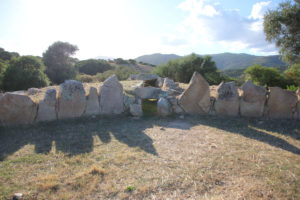Corpo Pagina
The area of Siniscola, located in the north-eastern cost of Sardinia, in the district of Nuoro, is the main center of the subregion of the Baronie; in this territory many archaeological remains of the prehistoric era have been discovered. In the dunes of Capo Comino geometric microliths in flint and obsidian from the Early Neolithic (5800-4800 a.C.) were found. This stones were used by man in antiquity, before the discovery of metals.
Traces of human presence, referable again to the Neolithic, have been documented outside the cave of Elène Portiche and in the surrounding area, thanks to the discovery of fragments of decorated vases and pierced shells. From a later period is the domus the janas located in the area of Cuccuru ‘e Janas, “hill of the fairies”; it is a subterranean tomb dug into the schist and with burial chambers arranged radially.
Other caves frequented since prehistoric times are the Bona Fraule one, where iron weapons were found, the Prejone ‘e Orcu, used as a burial site and a place of worship during the Nuragic age, Gana ‘e Gortoe, with many calcareous concretions (stalactites and stalagmites), and the Conca ‘e Locoli, a natural cave from which an underground river flows at the feet of Mount Albo.
The Nuragic era is attested by approximately thirty sites, including several nuraghi: Sas Piperas, located upper a sheer face of the Mount Albo, Sa Gurutta on Mount Lattu, Gorropis at the foot of Mount Tintiri, Conca Umosa and Paule ‘e Luca, located in the Berchidda valley, and the corridor nuraghe (or protonuraghe) Sa Domo Bianca, near the mouth of the Siniscola river, inside the garden of a house. The Pizzinnu nuraghe is also very interesting: in fact it has returned valuable artifacts, among which a melter’s pincers.
At the National Archaeological Museum of Cagliari are exposed some swords with tongue shaped bronze handle from the storage of Oroè, and the protome of a horned animal, part of a little bronze ship, from Bona Fraule. Of great importance are also the tombs of the giants Sas Kolovranas, built with granite blocks arranged in rows, Su Itichinzu, Su Piccante, made up with large stones embedded in the ground, and the Nuragic villages of Luthuthai and Rempellos.
There is notable evidence that this was a densely populated area in both Republican and Imperial Roman times: numerous sites, among which in Lonne area, Sant’Elene, San Giuseppe, have returned coins, pottery fragments and some burials.
Some Roman remains have been found also in the modern inhabited center, for example some cinerary urns and a storage room with denarii from Republican era.
tomba dei giganti “Su piccante” – ph.credits: Gianni Careddu,, via Wikimedia Commons


